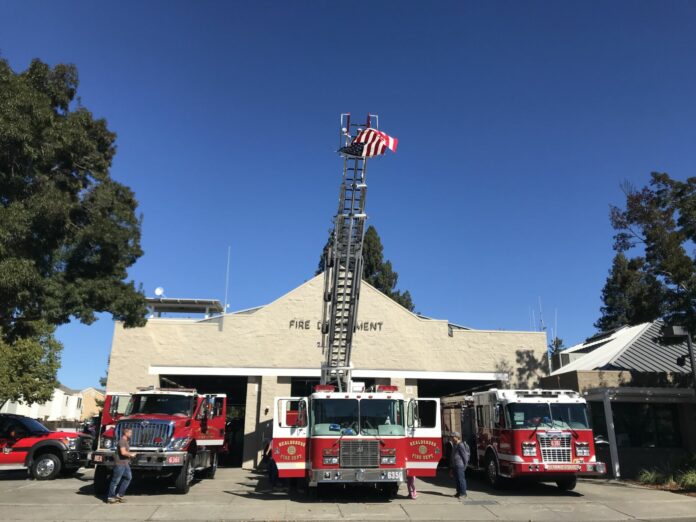Following multiple years of wildfires and a sense that this is in fact “the new normal,” it seems like an ideal time to pitch a sales tax increase to cover revamping and expanding fire services. However, plans for change and expansion have been in the works prior to the current sense of urgency. On the March ballot, Measure G, if approved, will add a half-cent to sales tax throughout the county.
The Sonoma County Board of Supervisors have been making the rounds at local city council meetings, pitching Measure G to the local municipalities. On Jan. 15, Supervisor David Rabbitt and Sonoma County Fire District Chief Mark Heine stopped in at a Windsor Town Council meeting to seek endorsement for the plan.
According to their presentation, Measure G was born out of a recognition that the current county-wide fire and emergency service delivery structure, funding and system structure is inadequate and does not meet National Fire Protection Association (NFPA) standards.
“Sonoma County is unique. We have more miles of roads than any of our neighbors and more parcels than most counties our size,” said Rabbitt. “Our solid urban growth limits ensure all of our cities have an urban wildland interface, and we do not have equal coverage throughout the county. That’s a fact.”
In addition, other complications include that Sonoma County residents are migratory — that is they travel through multiple jurisdictions throughout the day — and that the county fire service is an interdependent system. A Fire Service Working Group (FSWG) was convened in March 2019 to help craft the plan for solving these problems, though planning dates back to 2014.
The FSWG is comprised of Jason Boaz (chief, Healdsburg, County Chiefs’ Association President), Tony Gossner (chief, Santa Rosa, Cities’ Representative), Mark Heine (chief, Sonoma County FPD, State Chiefs’ Association), Steve Akre (chief, Sonoma Valley, EMS Representative), Dave Franceschi (chief, Forestville FPD, Region 5), Shana Jones (unit chief, Sonoma County, CalFire), Dan George (assistant chief, Gold Ridge FPD, VFC administrator), Mike Mickelson (assistant chief, Wilmar VFC, VFC Association), Joe Petersen (director, Gold Ridge FPD, Fire Districts’ Association) and Tim Aboudara (president, Santa Rosa, Fire Fighters L1401).
The future of firefighting
The specific recommendations of the group going forward include increasing the effective firefighting force available countywide, using an NFPA standard of three firefighters per engine; eliminating response boundaries to speed cooperation and response between fire districts; and increasing the overall strength of the system by reducing dependence on larger fire agencies, such as CalFire and larger entities around the state.
“When the Kincade Fire started, I ordered 500 engines, and I got it filled because there were no other active fires in state of California, something I’d never witnessed before in October or November. We were very fortunate,” Heine said. “In 2017, out of 100 strike teams I asked for, less than half were filled. Our lesson out of all this is that we are over relying on the ability to surge resources into this community. Our county is underserved because of lack of firefighters on duty. We should have staffing on duty to deal with threats day in and day out.”
Heine also added as a point of interest that the vast majority of calls fire companies respond to are medical emergencies rather than fires.
The centerpiece of the measure would be a substantial increase in staffing throughout the local fire system, adding 200-plus full-time staff throughout the county, including firefighters, vegetation management and fire prevention staff and additional battalion chiefs for regional command and control leadership.
Heine sees the vegetation management piece as critical and as a way to reduce fuel loads in rural and urban-wildland interfaces to prevent fires from entering cities. Management programs include things like a wood chipping program, roadside clearance near private and public roads, tree limbing and tree removal in targeted fire-prone areas and other fuel load reduction programs, such as controlled burns, to prevent future wildfires.
Funding will also be used to expand the emergency alert system, including a network of sirens on stations and apparatus, including hi-lo sirens; expanding community and neighborhood resiliency with door-to-door alerts; evacuations and red flag pre-positioning; and enhancement of Wireless Emergency Alerts (WEA), SoCoAlert and Nixle with investment in future alerting technology systems, such as satellite systems.
“We did a better job alerting in 2019 because we made a huge investment,” Rabbitt said. “But warning systems change rapidly, and there is no one, easy, single answer. It’s something we need to continue to make investments in. For the Kincade Fire, the wireless system was utilized 15 times and SoCoAlert 27 times. We lost track of home many Nixles we sent. The NOAA weather radio was used twice, for first the first time ever west of the Mississippi.
“This will take continual investment,” he continued. “There is no single pot of money to draw from to make sure we don’t fall behind. We’re talking about satellite technology (and things like) battery backup for cell towers. PSPS (Public Safety Power Shutoff) further complicates things and puts more pressure on our ability to communicate.”
Station improvement expenditures are budgeted at $6.8 million annually in order to allow funding for paying of construction loans and bonds. Region 3 will receive two station upgrades; Region 4 will get a station upgrade and one station move; Region 5 will get a station upgrade and three station moves; Region 6 will get a station upgrade and two new stations; Region 8 will get a station upgrade and one station move; and Region 9 will get a station upgrade, a move and two new stations.
And the station improvements are not just about expanded service. “Scarily, we found out in the county as a whole, 60% of our fire stations would not survive a 3.0 earthquake without significant damage,” Heine said.
How will the money be divided?
The tax money will be divided between all the fire districts in Sonoma County. The breakdown is follows:
• Cloverdale: 1.37% for alerts, warnings and sirens, as well as vegetation management and wildfire prevention and preparedness and response; 0.43% for recruitment and retention of firefighters.
• Sebastopol: 1.82% for alerts, warnings and sirens, as well as vegetation management and wildfire prevention and preparedness and response; 0.06% for recruitment and retention of firefighters.
• Bodega Bay: 1.22% for alerts, warnings and sirens, as well as vegetation management and wildfire prevention and preparedness and response; 0.88% for recruitment and retention of firefighters.
• Sonoma County Fire District (including Windsor): 3.19% for three new stations, relocating stations and station improvements; 4.41% for alerts, warnings and sirens, as well as vegetation management and wildfire prevention and preparedness and response.
• Healdsburg: 0.26% for a new station and station improvements; 1.28% for alerts, warnings, and sirens, as well as vegetation management and wildfire prevention and preparedness and response.
• Forestville: 2% for alerts, warnings and sirens, as well as vegetation management and wildfire prevention and preparedness and response; 0.42% for recruitment and retention of firefighters.
• Cazadero: 0.37% for relocating a station and station improvements; 1.82% for alerts, warnings and sirens, as well as vegetation management and wildfire prevention, preparedness and response.
• Gold Ridge: 0.37% for station improvements; 2.60% for alerts, warnings, and sirens, as well las vegetation management and wildfire prevention and preparedness and response; 1.03% for recruitment and retention of firefighters.
• Graton: 2.70% for alerts, warnings and sirens, as well as vegetation management and wildfire prevention and preparedness, and response.
• Monte Rio: 0.93% to relocate a station and make station improvements; 5.55% for alerts, warnings and sirens, as well as vegetation management and wildfire prevention and preparedness and response.
• Geyserville: 0.79% for a new station and station improvements; 4.13% for alerts, warnings and sirens, as well as vegetation management and wildfire prevention and preparedness and response; 0.43% for recruitment and retention of firefighters.
• Russian River: 0.75% to relocate stations and make station improvements; 0.76% for alerts, warnings, and sirens, as well as vegetation management, wildfire prevention and preparedness and response.
• Occidental: 2.78% for alerts, warnings and sirens, as well as vegetation management, wildfire prevention and preparedness and response
• The County of Sonoma Regional Vegetation Management and the County of Sonoma Department of Emergency Management will both receive stipends for alerts, warnings and sirens, as well as vegetation management and wildfire prevention and preparedness, and response.
• There are additional allocations for alerts, warnings and sirens, as well as vegetation management and wildfire prevention and preparedness and response in Community Service Area 40, which includes areas such as Camp Meeker, Bodega and Valley Ford among others, for a total of 13.42%.
Polls and plans
The results from polling and focus groups bode well for passage of Measure G, and that was before the Kincade Fire. They found that 2017 fires were still fresh in people’s memories, and there are concerns that a catastrophic fire could happen again. Voters in general believe that local firefighters are doing a good job, and they support making sure that firefighters have the resources they need. In addition, pollsters found that people have a significant interest in improved emergency alert systems. They found that only two other topics —housing/homelessness and infrastructure issues — were of greater concern to voters.
Consolidation of fire services has been occurring for the last couple of years and will continue with help from Measure G, both as a way to manage costs and resources but also to increase efficiencies. Cities with municipal firefighting services are exempt from the requirement for consolidation, but are free to join with nearby districts if they wish. For non-municipal districts, Measure G funding is provided as long as agencies pursue regional consolidation; in other words if they want to keep the money flowing, they must consolidate with other districts.
In order to ensure compliance, the Board of Supervisors in partnership with the Local Agency Formation Commission (LAFCO) will conduct consolidation reviews every three years. Any reduction in funding requires a four-fifths vote by the Board of Supervisors.
Measure G will appear on the March 2020 ballot. It will require a two-thirds majority to pass.
51.5
F
Healdsburg
March 12, 2025








